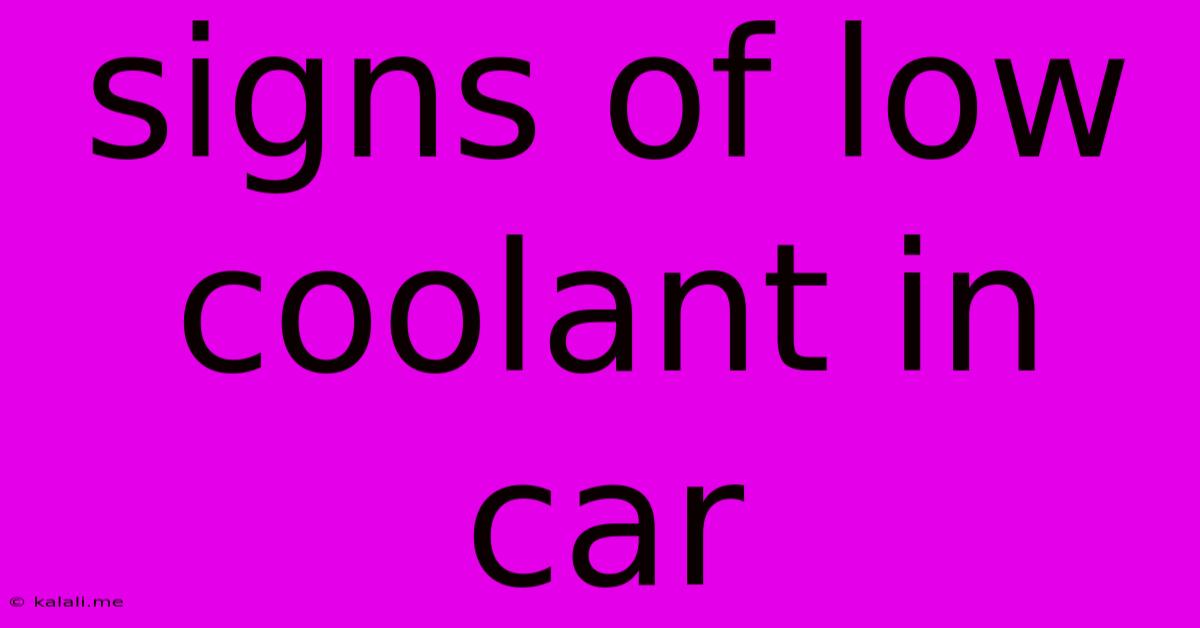Signs Of Low Coolant In Car
Kalali
May 30, 2025 · 3 min read

Table of Contents
Signs Your Car is Running Low on Coolant: A Comprehensive Guide
Meta Description: Is your car overheating? Learn to identify the key signs of low coolant, from subtle temperature gauge fluctuations to ominous steam clouds. This guide helps you diagnose and address coolant issues before serious engine damage occurs.
Losing coolant in your car is a serious issue that can lead to engine overheating and costly repairs if ignored. Recognizing the signs early is crucial for preventing major problems. This article covers the most common indicators that your vehicle's coolant level is dangerously low.
Visual Signs of Low Coolant
The most obvious (though not always the first) sign is a low coolant level in the reservoir tank. Check this regularly, especially before long trips. The reservoir is usually a translucent plastic container located near the engine. The tank will typically have minimum and maximum markings; the level should ideally fall somewhere between them. A level significantly below the minimum is a clear warning sign.
Another visual clue might be white smoke or steam emanating from the engine bay. This is a clear sign of overheating and often indicates a serious coolant leak. If you see this, pull over immediately and turn off the engine to prevent further damage. Don't attempt to open the hood immediately as the system may be under pressure and could cause scalding.
Look carefully for leaks around the engine. Check hoses, the radiator, the water pump, and the thermostat housing for any signs of dripping coolant. Coolant is typically a greenish, yellowish, or orange-colored liquid. Even a small leak can lead to significant coolant loss over time.
Performance-Based Signs of Low Coolant
Sometimes, the warning signs are more subtle and performance-related. Pay close attention to your car's behavior:
- Overheating: Your car's temperature gauge is the most important indicator. If the needle climbs towards the "H" (hot) mark or the red zone, this is a critical sign of overheating, almost certainly due to low coolant.
- Temperature Gauge Fluctuations: Even if it doesn't reach the red zone, inconsistent temperature gauge readings, fluctuating wildly between normal and high temperatures, can signal a problem.
- Engine Misfires or Stalling: Low coolant can cause the engine to overheat, leading to misfires or even stalling. This is especially true if the engine is under stress (e.g., driving uphill or in heavy traffic).
- Reduced Engine Performance: Your car might experience a loss of power or sluggish acceleration if the engine is not properly cooled due to insufficient coolant.
Other Indirect Indicators
While not direct signs of low coolant themselves, these can indicate underlying problems that often lead to coolant loss:
- Sweet Smell: A sweet, almost sugary smell coming from the engine bay could indicate a leak in the cooling system. This smell is characteristic of many coolant types.
- Sticky Residue: Look for a whitish or greenish residue around the engine components, another sign of a leak.
What to Do If You Suspect Low Coolant
If you notice any of these signs, do not ignore them. Pull over in a safe location, allow the engine to cool completely, and then check the coolant level. If it's low, carefully add coolant (use the correct type specified in your owner's manual). Never open the radiator cap while the engine is hot. If the problem persists or you're unsure how to proceed, consult a qualified mechanic immediately to diagnose and repair the leak. Driving with low coolant can cause catastrophic engine damage.
This article provides a comprehensive overview of common signs indicating low coolant. Remember that regular maintenance, including checking coolant levels, is crucial for preventing costly repairs and ensuring the longevity of your vehicle. Proactive care will keep your engine running smoothly and prevent unexpected breakdowns.
Latest Posts
Latest Posts
-
Which Man Is Carrying The Most Weight
May 31, 2025
-
Remove Oil From Driveway Using Muratic Acid
May 31, 2025
-
Can You Use Galvanized Pipe For Gas
May 31, 2025
-
How Much Dry Yeast In A Packet
May 31, 2025
-
How Can You Keep Mice Out Of Your House
May 31, 2025
Related Post
Thank you for visiting our website which covers about Signs Of Low Coolant In Car . We hope the information provided has been useful to you. Feel free to contact us if you have any questions or need further assistance. See you next time and don't miss to bookmark.